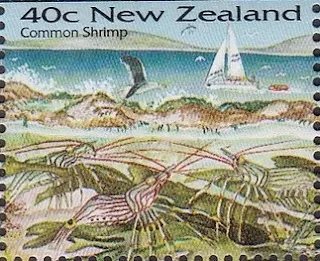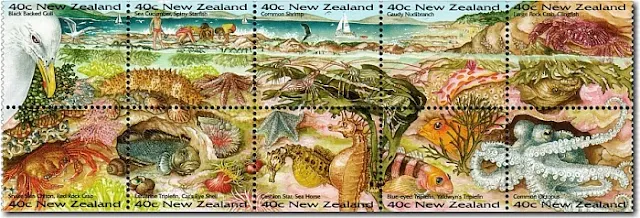Rockpools are an integral part of the New Zealand Seashore, this stamp booklet issue depicts this unique environment. When joined together, the stamps formed a continuous picture across all ten stamps of the booklet.
The seashore rock pool is a unique environment in which not all sea creatures can survive. At high tide, it is completely submerged under water, sometimes covered by up to a meter. As the tide goes out, the rock pool is swept with the waves of the falling tide before becoming completely isolated from the ocean. It is at this point that the water left in the pool can get heated by the hot summer sun, sometimes almost drying up the pool. Then in comes the ocean again, a period being swept by the waves before the rock pool is completely submerged again. A tough environment, while many can't survive, many others, as featured in this issue, can survive and thrive.
View of a seashore rock pool with some marine creatures found in such pools.
The Ten Stamps.
(Gummed Mint.)
The upper five stamps combined a seashore scene with closer views of seashore wildlife.
40c - Black Backed Gull.
Coastal beach scene in the background.
40c - Sea Cucumber, Spiny Starfish.
Children exploring a seashore rockpool.
40c - Common Shrimp.
Seashore and yachting in the background.
40c - Gaudy Nudibranch.
A beach scene in the background.
40c - Large Rock Crab, Clingfish.
The bottom five stamps focused on wildlife in and under the water.
40c - Snake Skin Chiton, Red Rock Crab.
40c - Estuarine Triplefin, Cats Eye Shell.
40c - Cushion Star, Sea Horse.
40c - Blue-eyed Triplefin, Yaldwyn's Triplefin.
40c - Common Octopus.
The seashore booklet was first issued in February 1996 as a gummed booklet and was subsequently reissued as a self-adhesive booklet in August 1996.
1996 Seashore Rock Pool Gummed Booklet.
21 February 1996.
Seashore Booklet Cover (Gummed).
Se-tenant Block of ten 40 cent stamps from Booklet.
First Day Cover - 21 February 1996.
1996 Seashore Rock Pool Self Adhesive Booklet.
7 August 1996.
Seashore Booklet Cover (Self-adhesive.)
First Day Cancelled booklet - 7 August 1996.
Technical information.
Date of issue: 21 February 1996.
Designer: Sue Wickison, Wellington, New Zealand.
Printer: Southern Colour Print, New Zealand.
Stamp size: 30mm x 25mm.
Sheet size: Booklets of 10 stamps.
Process: Lithography.
Perforation gauge: 14; Die cut perforations.
Paper type: Harrison and Sons and JAC self-adhesive, red phosphor coated, unwatermarked.
Period of sale: These stamps remained on sale until 21 February 1997.
Some of the images in this post were used with permission from the illustrated catalogue of StampsNZ
You can visit their website and Online Catalogue at, http://stampsnz.com/
Information & images for this post came from.

















We appreciate your engagement with our content. To ensure a respectful and constructive community, please take note of the following:
- No Spam, Please: We do not tolerate spammy or promotional comments. Any such comments will be promptly removed.
- Moderation in Place: All comments are moderated to maintain a positive and inclusive environment. Please be patient, as it may take a little time for your comment to appear.
- Sign In with Google: To comment, please sign in using your Google account. This helps us maintain the integrity of our community and allows for better interaction.